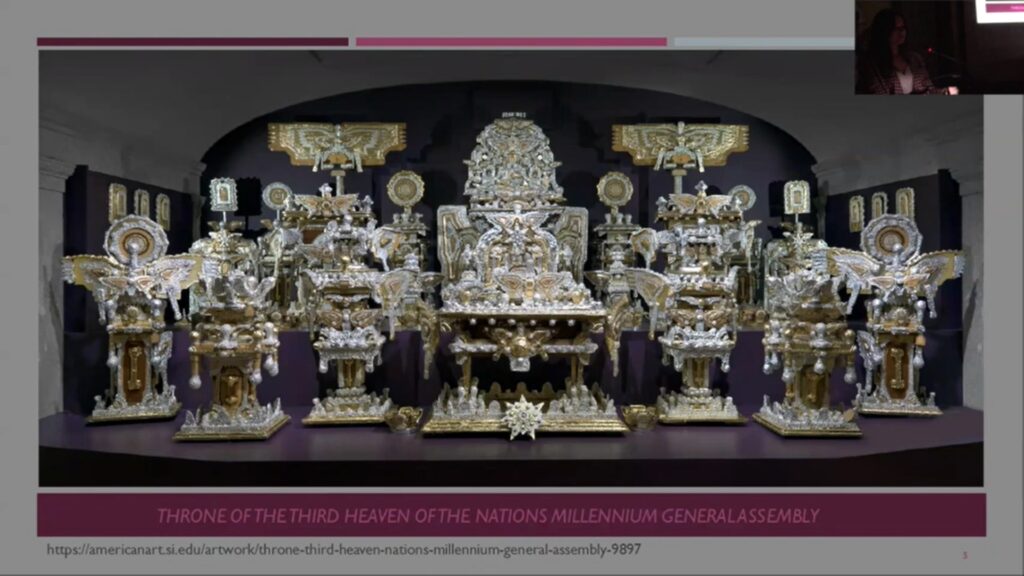Speaker: Katya Zinsli Lunder Conservation Fellow, Smithsonian American Art Museum
Summary by Anna Nielsen
During the WCG’s Emerging Professionals Talks, Katya Zinsli, Smithsonian American Art Museum, Lunder Conservation Fellow, shared the work she has been doing on The Throne of the Third Heaven of the Nations’ Millennium General Assembly by James Hampton and her insights into the work processes.

The Smithsonian American Art Museum (SAAM) has the privilege of stewarding this artwork, comprised of nearly 200 components constructed of found materials like furniture and silver and gold-colored foils. Several campaigns of examination and treatment have been conducted on a portion of about 60 components of Hampton’s Throne; but the remaining components had never been fully documented—until this year with the start of a collaborative project between the museum’s conservation and registration departments that will examine, document, and research the remaining components over the next two years. This talk covered the history of the Throne over the last 70 years and the ongoing approach to managing documentation and treatment of an artwork of this scale. Zinsli began by giving some background on James Hamptons life and how the museum came to acquire the Throne after his death in 1964.
Zinsli’s fellowship began in November by continuing the documentation and dusting the on-view portion of the Throne. She noted typical condition issues, including lifting aluminum or paperbacked foil; tears in the paper, foils, or plastic sheets; fading paper and inks; loose decorative elements; and corrosion on the ferrous nails and various foils. The work was examined, photographed, and cleaned in a temporary space within an uninstalled gallery. Zinsli described starting the project by evaluating previous documentation for each object. This allowed her to become familiar with previously noted condition and handling concerns. After careful examination, she compiled condition notes, treatment recommendations, and relevant information in Excel, followed by taking detail photographs of areas of concern and condition changes. She then vacuumed the work on low suction with a soft bristle brush and further cleaned it with dry cosmetic sponges. Then began minor stabilization treatments, which mostly involved tacking down foil or bridging tear gaps with Japanese tissue. This process began in November and continued through to mid-January so the work could be reinstalled.
Given the size of the project, the work completed by January only accounted for 1/3rd of the Throne. The remaining two-thirds of the assemblage of objects had not been viewed for decades. Most of the pieces had been in storage at an off-site facility and had not yet been cataloged. Zinsli is working with registration fellow, Eliza Macdonald, to address the problem of scholarly access to the piece. The workflow of the two working together is as follows: As each box is unpacked, Macdonald performs measurements, photography, a brief condition check, and finally assigns a temporary ID. Zinsli then examines the object and documents it through a survey and photography.
Zinsli designed a specialized condition survey specifically for this project. She had found that online forms such as Microsoft and Google Forms are great resources. They link results to an Excel sheet and auto-generate graphs, making it easier to extrapolate data. The advantages of using Google forms include flexibility to edit entries and generate pre-filled forms for objects of similar materials and design.
The information captured by the survey identifies broad tombstone information as well as numerous other methods of identification including the temporary ID, box number, the individuals responsible for the categorization, common design elements, overall description, and structural description. Additionally, the survey documents the condition as excellent, good, fair, or poor. Condition issues are then broken down by location and the layer they affect. The survey form concludes with the treatment priority assignment with specific recommendations, including topics such as handling, exhibition, and storage. Looking forward, Zinsli intends to make the Throne more accessible and to learn more about each object that makes up the artwork overall. SAAM will be holding public programming and open conservation viewing in the near future.
If you would like to see part of this stunning work in person, visit the Smithsonian American Art Museum (SAAM) in Washington D.C.!
A recording of this presentation is available on WCG’s YouTube Account.